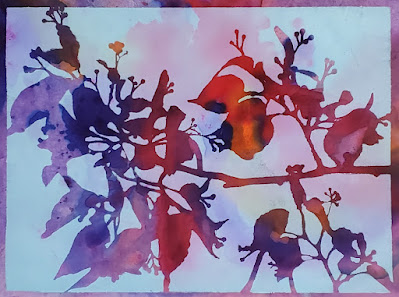From Day 1 to now, more than nine years since I had the happy experience of designing for StencilGirl, there has always been something I need to either learn. With my new release, 9" x 12" Fire Cherries Mask L879, what I've perhaps learned the most has been on the topic of backgrounds. This particular mask has challenged me more than any of my earlier masks, but that's all to the good.
When I started to play with this mask, I limited myself to using heavy-body acrylic paints with sponges.
But I'd forgotten, or "mentally misplaced," the fact that I own these brushes. Once I went back to using them with this mask, I discovered that -- at least in my hands -- they do a better job than sponges in areas of fine detail. They help me to be more accurate in following the delicate patterns of this mask.
And they excel at blending from one color shade to the next.
Another bonus is that using them is kinder on the wrist, because the pressure in the pouncing need not be as much as it has been with the sponges I'd chosen earlier in adventuring with this mask.
In fact, with these soft and densely packed brushes, pouncing is only one option. In areas that aren't so finely detailed, a swirling motion is another option -- a quick and easy way to spread paint quickly, with a smooth finish.
A new question I started asking: Is this potential background painted with a medium that may re-hydrate when I print over it with a damp medium? The question popped up when I began to use papers that I'd colored many years ago. Of course, everything colored with acrylic paints had permanent color that wouldn't react to the addition of a new, damp layer of paint. Examples:
 |
| Above: Besides illustrating that acrylic painted backgrounds are stable, this piece also hints at the ease of color shade shifting possible once I'd switched from sponges to these brushes. It was certainly possible to do this top-layer, foreground shade shifting and blending with sponges, but the brushes made my work easier and faster as I merged purple areas into magenta areas. |
 |
| Above: Like the painting before this one, this was created on an old calendar page photo that I had used as "catch-all" paper, with the result that it bore a mottled look before I added my foreground with Fire Cherries Mask (9" x 12".) Both background and foreground were done using heavy-body acrylic paints. |
In addition to using old papers that I'd covered with acrylic paints, I came across a soft printmaking paper that had absorbed some kind of water-based paints; that paper looked like this--
 |
| Directly below, you can see the print I made atop this. |
Below: a first example of making a print with this mask and an opaque acrylic paint; notice how the multi-paint-colored background has been completely hidden so that it shows only as definition for the stems, leaves and fire cherry clusters.
 |
| Above: The paper that I used to create this art sample is shown directly below. |
Fire Cherries Mask. Like the last art sample, this one was created on an old calendar photo page that'd been used as "catch-all" paper to keep leftover acrylic paints from being washed down a drain. This art sample is shown in its entirety as well as in two close-ups:
For more background variety, consider this art sample that I'd posted several days ago --
 |
| Above: Notice the big difference when a translucent acrylic paint is used with Fire Cherries Mask L879 -- this translucence lets the background (printed using Winter Berries Mask L677) remain visible, without being the star of the show. |
Today's final art sample, below, is a background paper created using Fire Cherries Mask L879 and Winter Berries Mask L677. It is just that -- a background paper, a vague base waiting for an image to be printed atop it ....
My sincere thanks for your stopping here at my blog today! To scroll thru the pages of my StencilGirl masks and stencils, please start here.







No comments:
Post a Comment